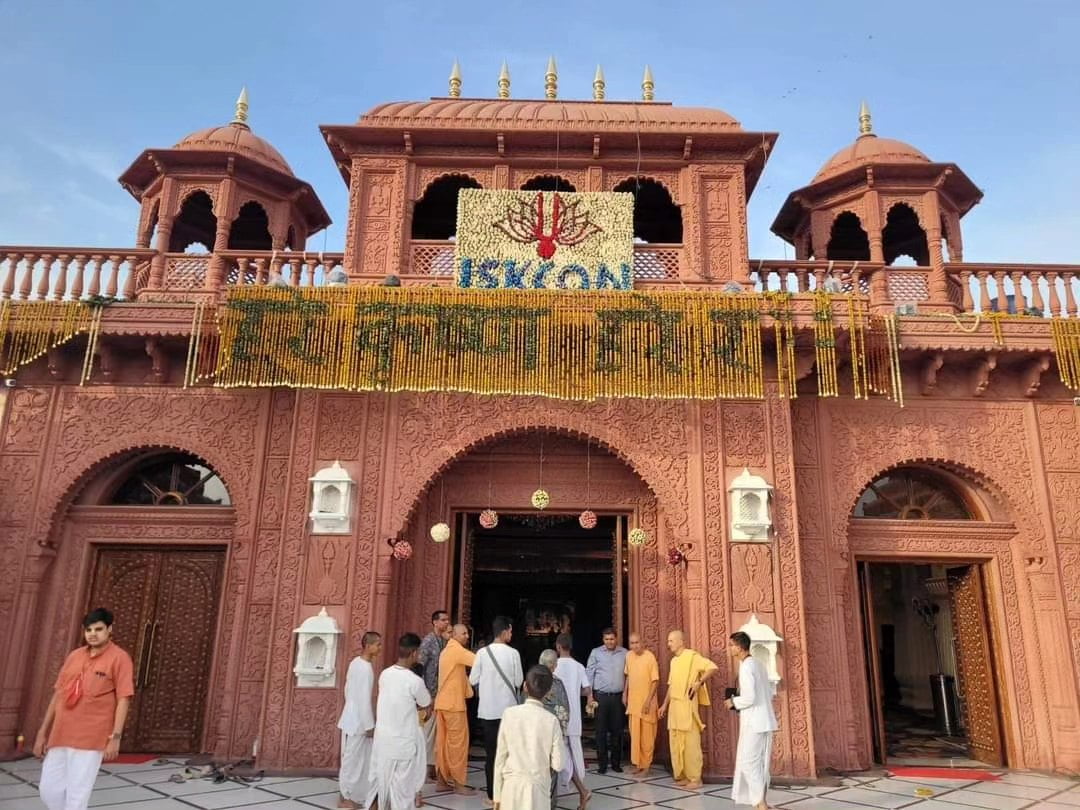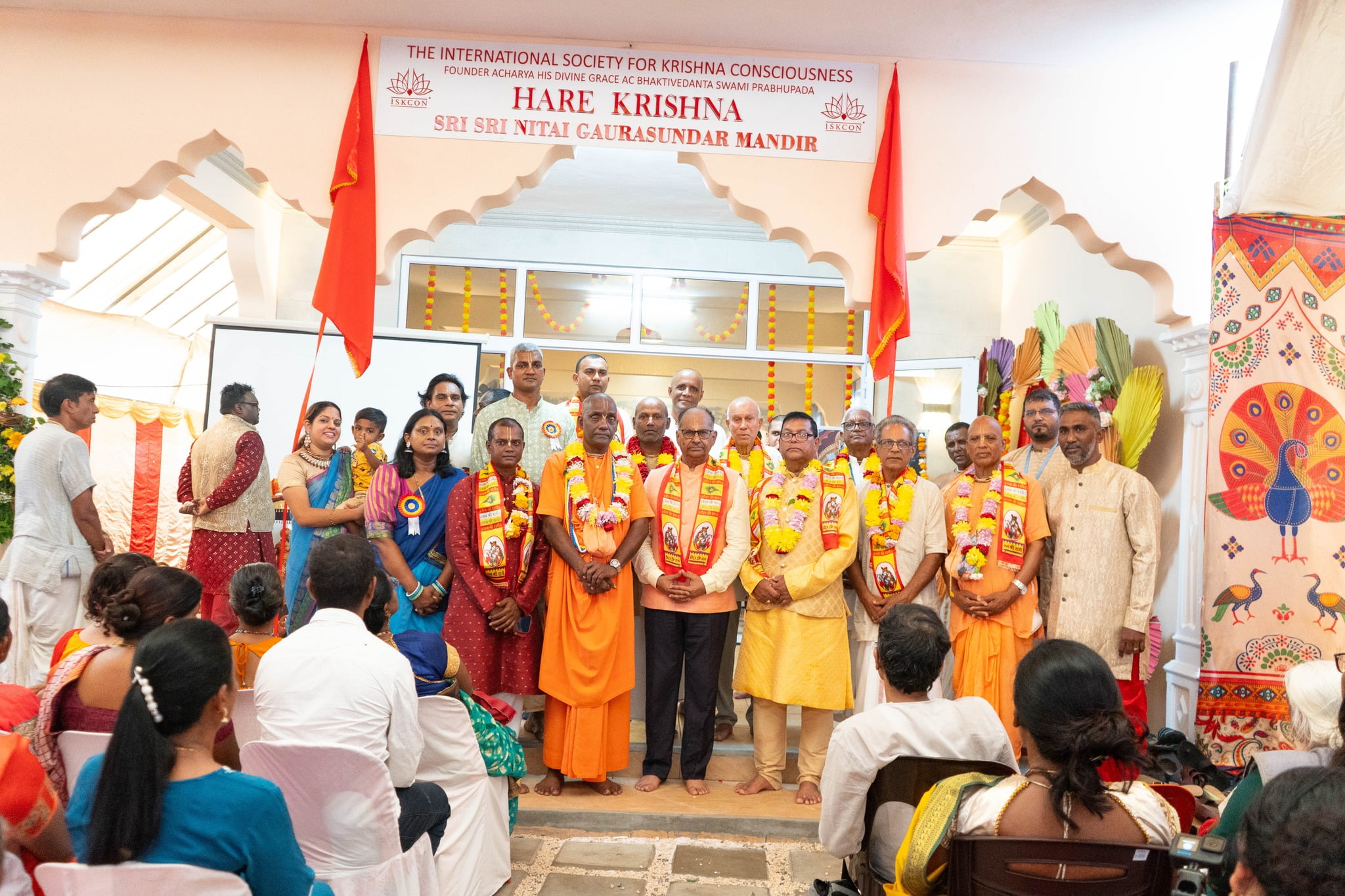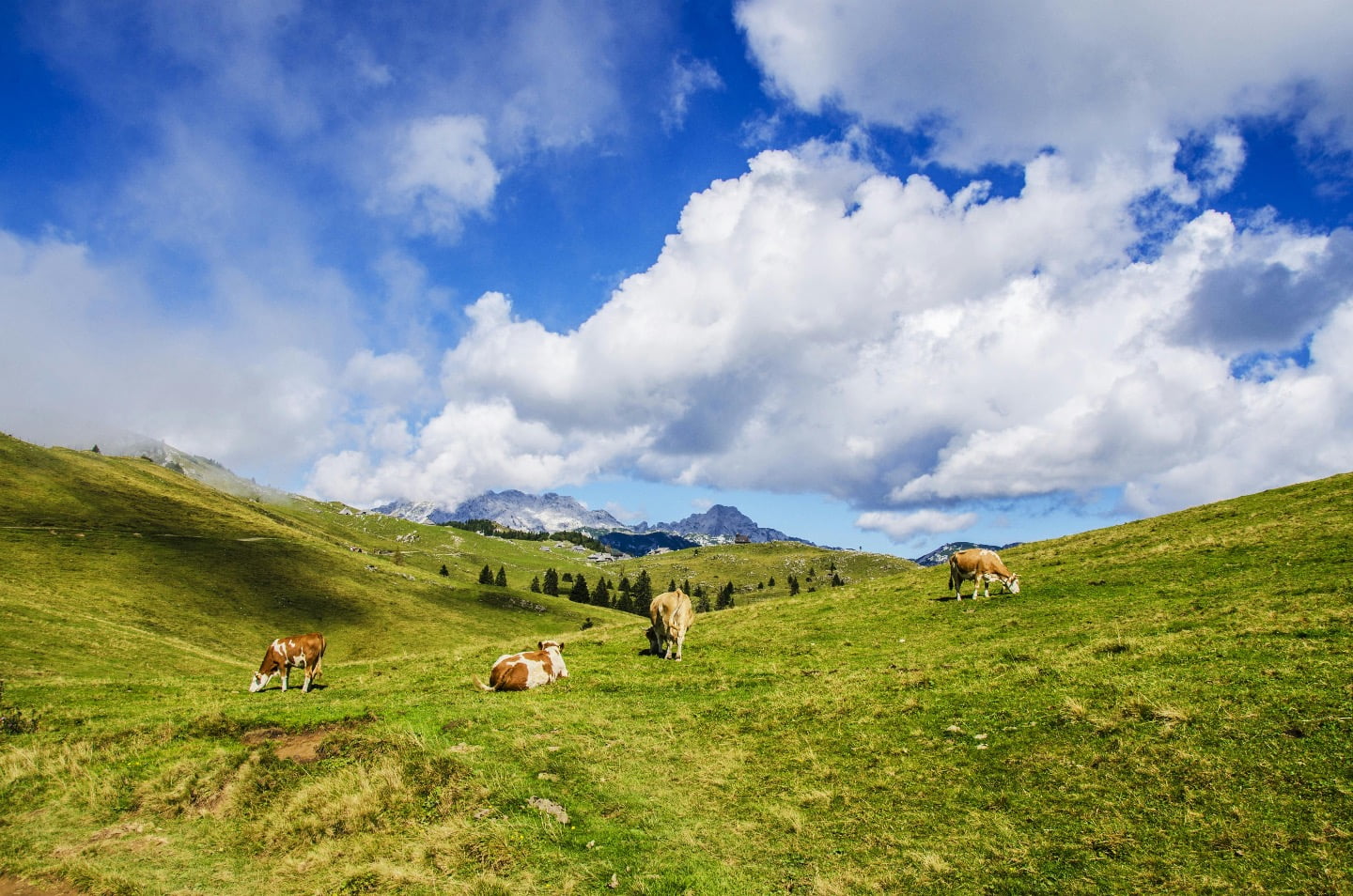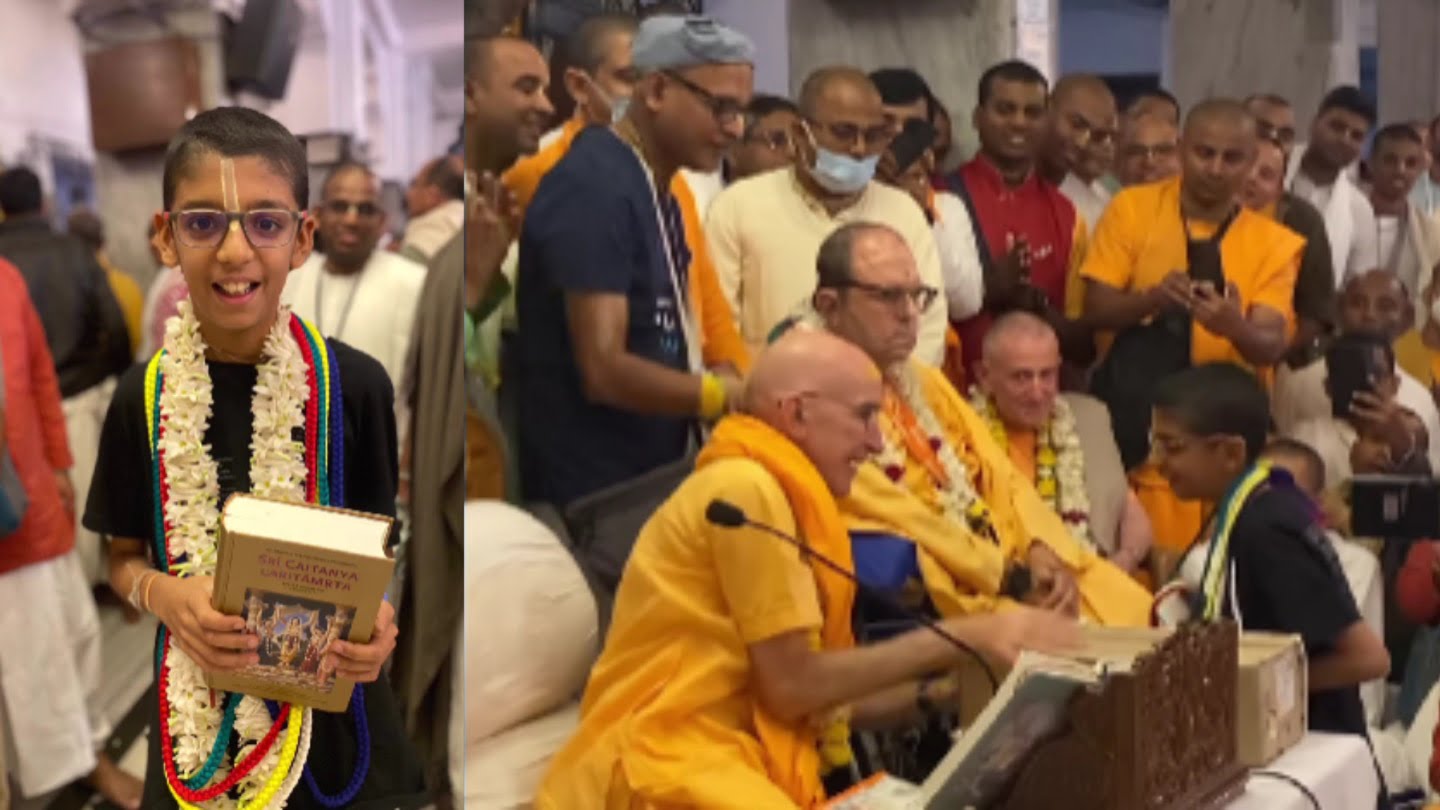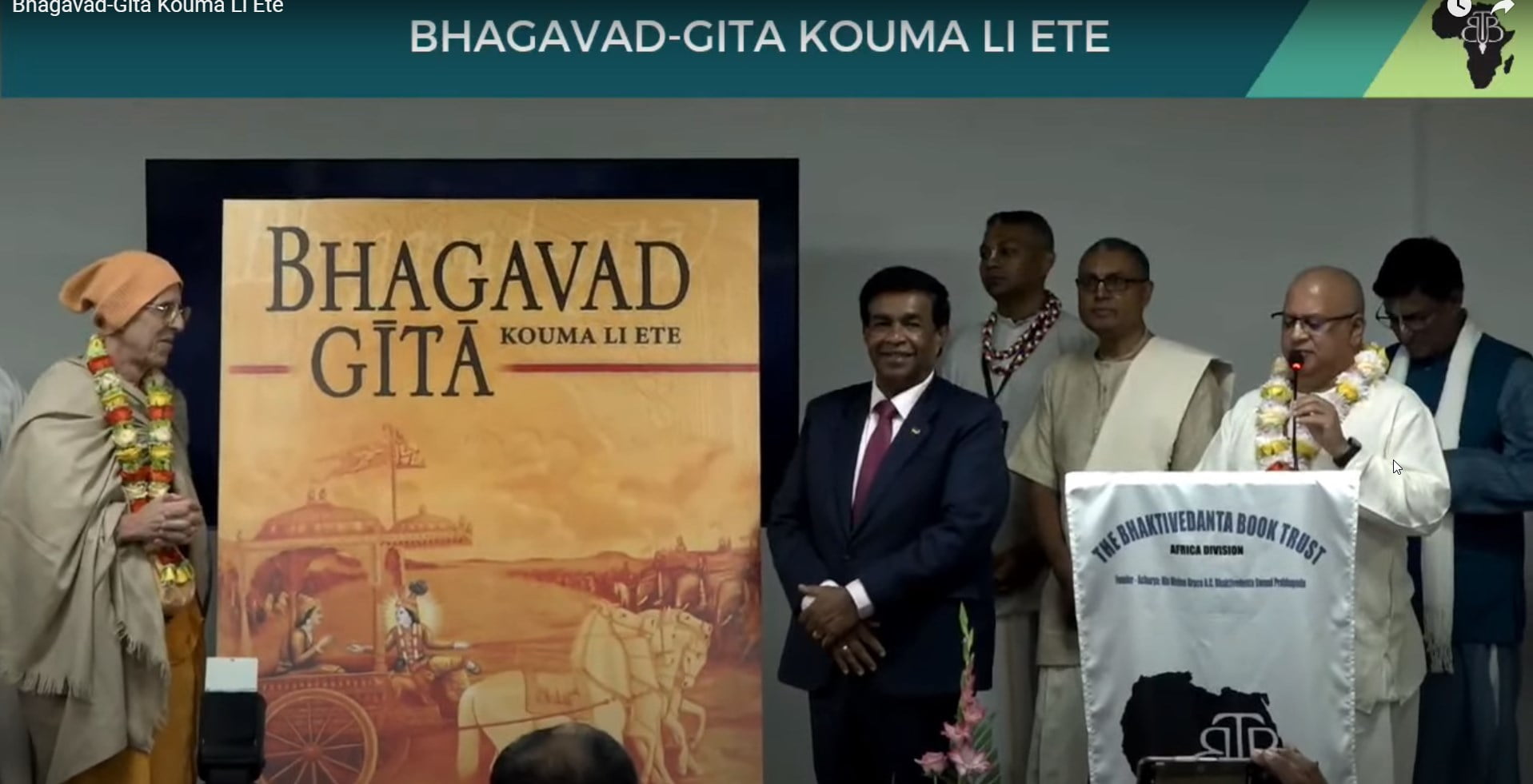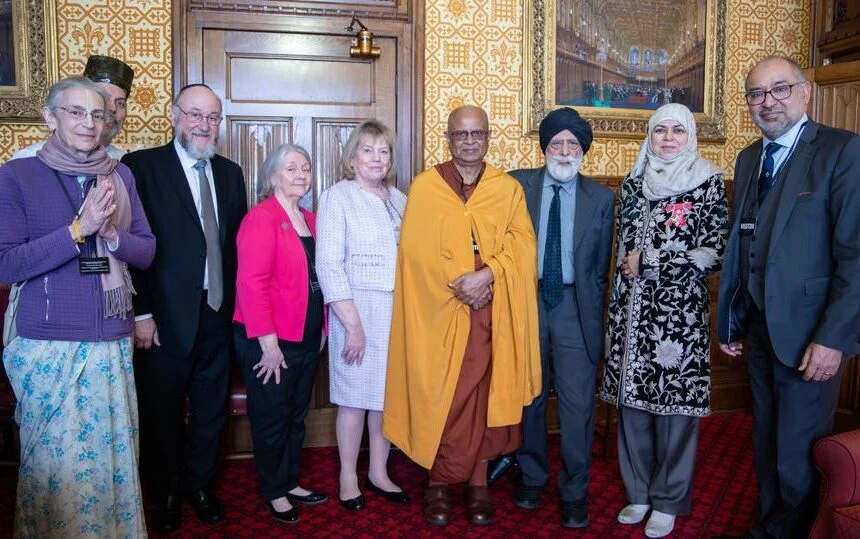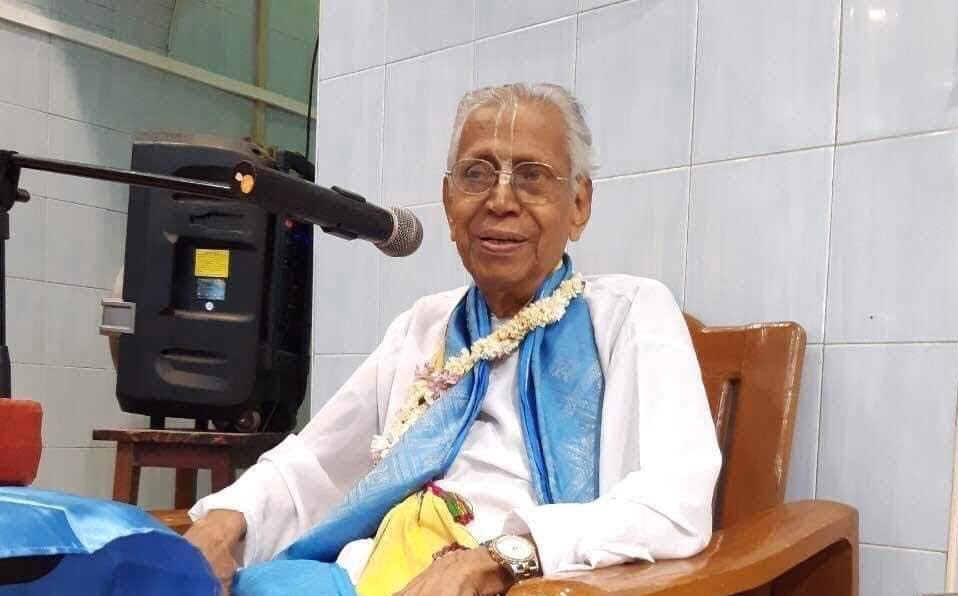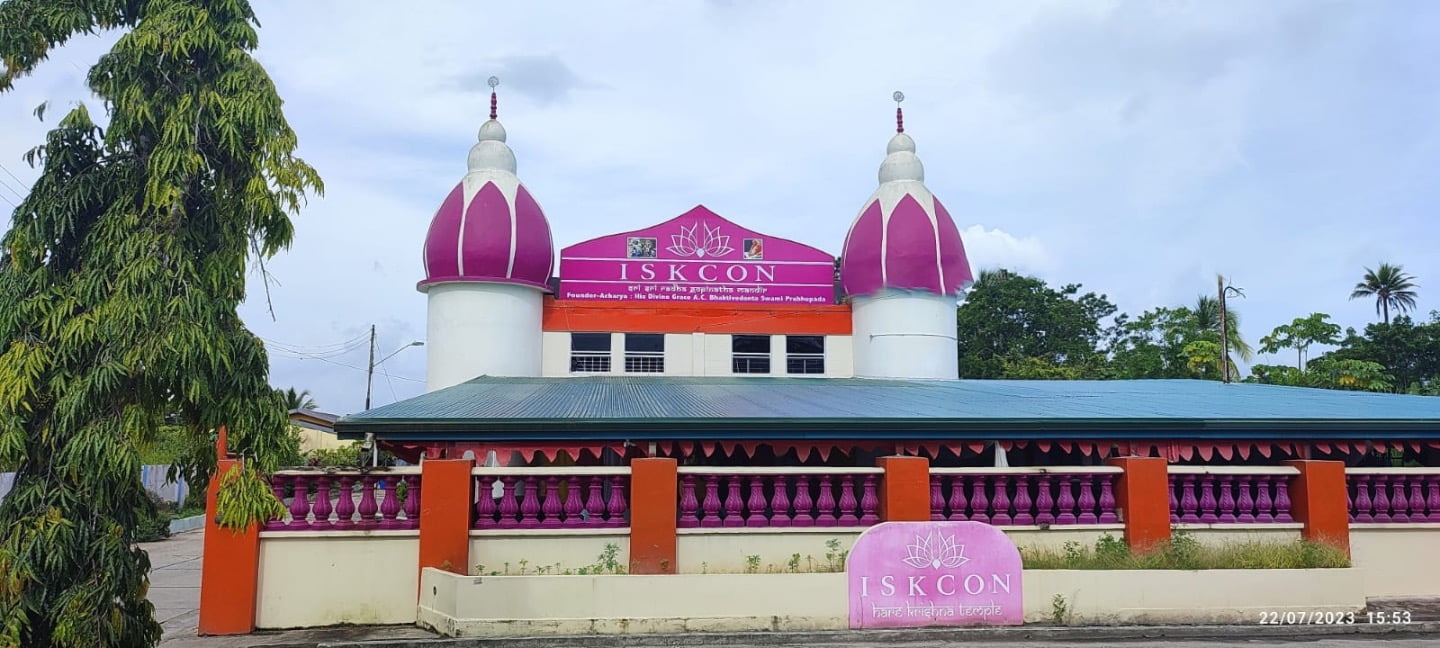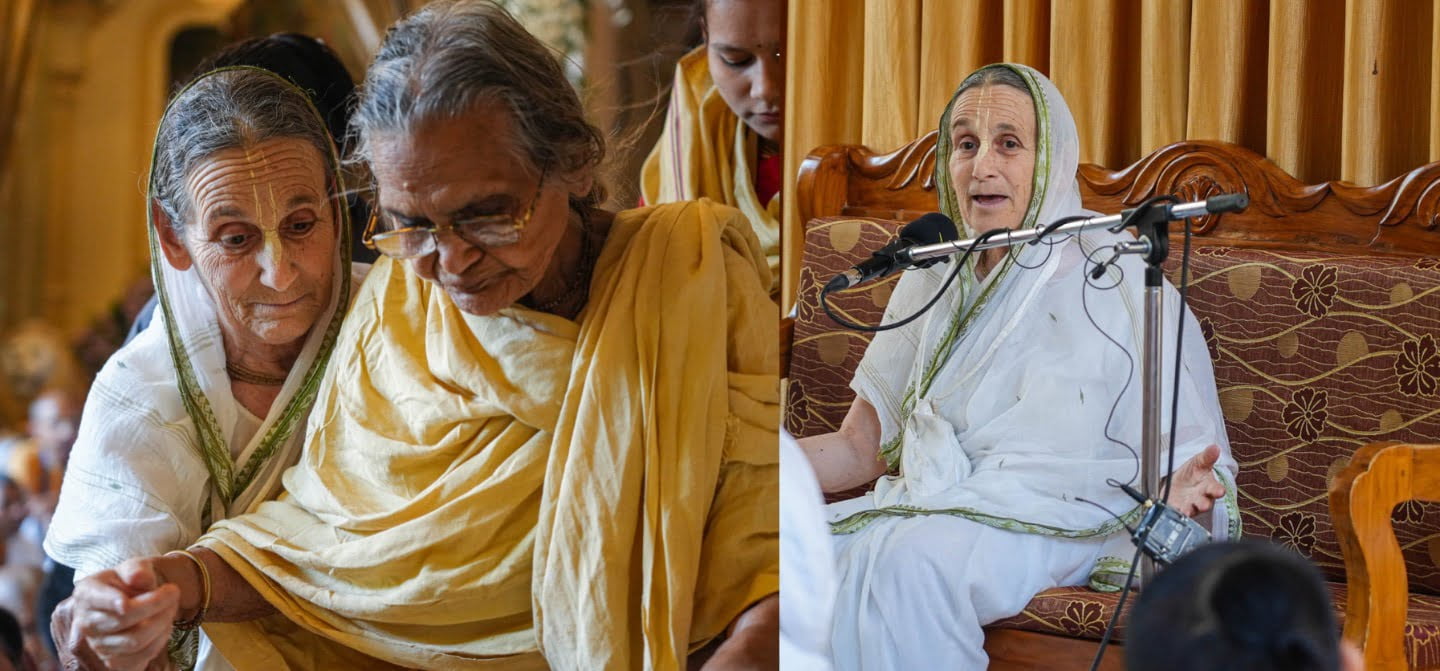50 Years of ISKCON – The Joy of Devotion
By Romapada Das, International Coordinator, ISKCON 50 | Jul 15, 2016

13th July 2016, is the the 50th anniversary of the incorporation of ISKCON.
Over fifty years ago in September 1965, an elderly Indian monk stepped off the piers of New York harbour wearing orange Indian robes and sporting a dignified vaishnava tilak mark on his forehead. He was carrying just seven dollars, a few sets of clothes and two trunk-loads of books. The aristocratic looking monk was A. C. Bhaktivedanta Swami Prabhupada, who had been sent by his spiritual master from India to preach the message of the Bhagavad-gita to the western world.
In just ten short years, Srila Prabhupada, who came to America almost penniless, established a worldwide community of devotees practising India’s ancient science of bhakti-yoga, wrote 75 books, and established over 108 centres across five continents, that made ‘Hare Krishna’ a household name all over the globe.
The legacy
Behind Srila Prabhupada’s success lay a spiritual tradition that traced its origins to a disciplic succession which had originated more than 5000 years ago. Srila Prabhupada carried with him the essential message of Lord Krishna as given in the Bhagavad-gita: all souls are eternal, and real happiness is found by awakening our loving relationship with the all-attractive Supreme Personality of Godhead.
Srila Prabhupada was a spiritual master in the line of Sri Caitanya Mahaprabhu, the 16th century saint and avatar, who taught that the best way to awaken our joyful spiritual identity is to chant the names of God, especially the Hare Krishna maha-mantra.
The succession
Sri Chaitanya’s tradition continued through a series of spiritual masters to Srila Bhaktivinoda Thakura, a prominent thinker of Bengali Renaissance, and a leading philosopher, savant and spiritual reformer.
He single-handedly revived the teachings of Lord Chaitanya in India in late 19th and early 20th century. Srila Bhaktivinoda was hailed by contemporary scholars as the most influential Gaudiya Vaishnava leader of his time.
His son, Srila Bhaktisiddhanta Saraswati Thakura carried on the legacy of his father by establishing the Gaudiya Math. It grew to sixty-four branches across India and had three centres abroad.
The mission initiated by Srila Bhaktivinoda and developed by Srila Bhaktisiddhanta emerged as ‘the most powerful reformist movement’ of Vaishnavism in Bengal of the 19th and early 20th century.
Srila Prabhupada met Srila Bhaktisiddhanta Saraswati in 1922, and accepted him as his guru.
The Mission
Srila Prabhupada accepted formal initiation into Gaudiya Vaishnavism from Srla Bhaktisddhanta Saraswati in 1933.
Srila Bhaktisiddhanta Saraswati picked out Srila Prabhupada and instructed him to spread the message of Sri Chaitanya Mahaprabhu in English to the Western world. Once, he requested Srila Prabhupada: “If you ever get money, print books’.
Srila Prabhupada took both of these instructions as his life’s mission. Soon, he started a magazine called Back to Godhead in 1944. He singlehandedly typed, proofread, published and distributed the magazine on the streets of India.
In 1956, he moved to reside in the holy town of Vrindavan, and in 1959, he accepted the renounced order of life, or sannyasa.
Srila Prabhupada set sail for the USA on 13 August 1965, on board the steamship, Jaladuta.
After two heart attacks, illness and sickness, Srila Prabhupada arrived in America on 17 September 1965.
While the ship was docked in Boston Harbour, Srila Prabhupada wrote two poems in which he revealed his prayerful dependence on Lord Krishna for the success of his mission.
In one of his compositions, he appealed to Lord Krishna: “How will I make them (the American public) understand this message of Krishna consciousness? I am very unfortunate, unqualified and most fallen. Therefore I am seeking Your benediction so that I can convince them, for I am powerless to do so on my own.”
The Beginning
Srila Prabhupada initially stayed in Butler, and later moved to New York in 1966. Many ‘hippies’ flocked to hear his teachings.
He finally set up a store-front centre at 26, Second Avenue. On 13 July 1966, he incorporated the ‘International Society for Krishna Consciousness’ (ISKCON). In August 1966, Srila Prabhupada led the first public chanting of the Hare Krishna Mahamantra.
In 1966, Srila Prabhupada established the ISKCON Press to publish Gaudiya Vaishnava literature. In 1967, he travelled to San Francisco where the Hare Krishna mantra was sung at the Mantra Rock Dance
He also organised the first ever Jagannatha Ratha Yatra in San Franciso. In 1968, Macmillan published Srila Prabhupada’s Bhagavad-gita commentary.
In the same year, Srila Prabhupada sent three married couples to London, where they met the Beatles in 1969.
Apple Records released the Hare Krishna mantra, which sold 70,000 copies on the first day, and appeared on Top of the Pops. Srila Prabhupada visited London in 1969, and stayed at John Lennon’s estate.
The expansion
By 1970, Srila Prabhupada had established temples in USA, UK, India, parts of Asia, South America and Australia. In 1970, Srila Prabhupada returned to India with his Western disciples.
Srtila Prabhupada had elaborate plans for India upon his return. He established several centres in India including major temples in Mumbai, Vrindavan and Mayapur.
In 1971, Srila Prabhupada visited Russia and initiated a young man as his disciple.
Later Srila Prabhupada established the Governing Body Commission to manage the affairs of ISKCON.
Srila Prabhupadaleft this world in November 1977. By then he had:
- Established over a hundred temples and farm communities
- Travelled the world seven times
- Initiated over five thousand disciples
- Written over 80 books
- Founded the world’s largest publishing and distributing house for Vedic literature
- Started the world’s largest vegetarian food relief programme
- Introduced Indian festivals and culture such as Ratha Yatra to scores of Western cities around the world
- Initiated the concept of ‘simple living and high thinking’ through several farm communities around the world
It was Srila Prabhupada who fulfilled a prediction made by Lord Chaitanya 500 years ago that ‘in every town and village’ the holy name of Krishna will be heard.
The explosion
Srila Prabhupada’s disciples carried on the Founder’s vision by continuing to expand his movement under the guidance and instructions he had left behind.
In the fifty years since 1966, ISKCON has achieved many milestones, as given below:
- 650 – the number of ISKCON centres, temples and schools worldwide
- 520 million – the number of books and magazines published by Bhaktivedanta Book Trust and distributed by ISKCON devotees worldwide
- 3 billion – the number of free plates of sanctified vegetarian meals distributed worldwide since 1966
- 18 million – the number of people who worship in ISKCON temples around the world, every year
- 1.2 million – the number of meals distributed every day to needy school children in India by ISKCON Food Relief Foundation, also known as ‘Annamrita’ as part of the Government’s mid-day meal programme
- 340,000 – the number of patients treated by ISKCON hospitals such as Bhaktivedanta Hospital in Mira Road, the Bhaktivedanta Hospice in Vrindavan, mobile clinics and eye camps
- 260,000 – 2.6 million devotees walked 260,000 kms visiting 52,000 towns and villages in 170 countries as part of the worldwide padayatra to bring the holy name to every town and village around the world
- 100,000 – since 1966 over 100,000 devotees around the world have taken spiritual initiation into the Gaudiya tradition
- 6000 – there are more than 6000 Hare Krishna festivals held every year around the world
- 3600 – the number of home study groups (Bhakti Vriksha groups) around the world
- 110 – the number of Hare Krishna restaurants around the world
- 65 – the number of eco-friendly farms run by ISKCON to practice ‘simple living and high thinking’
The books
In the 1970s, Srila Prabhupada translated almost sixty volumes of books including:
- Bhagavad-gita
- SrimadBhagavatam
- Chaitanya Charitamrita
- Nectar of Devotion
- Nectar of Instruction
- Sri Ishopanishad
ISKCON temples and inspired members began selling them at temples, mobile travelling parties and public venues. In 1972, Srila Prabhupada established the Bhaktivedanta Book Trust (BBT). BBT is now the world’s largest publisher of books in Indian and Vedic religion and philosophy.
Srila Prabhupada’s books have been translated into more than eighty languages and are studied in university courses. His books have won praise for from professors at universities including Harvard, Oxford and Edinburgh.
The most important contribution of Srila Prabhupada’s books is that they have transformed the lives of millions, who lead a life based on the principles of ‘devotion to God and service to all’.
The temples
ISKCON’s 650 temples are hubs of devotional activity and spiritual rejuvenation. People from different backgrounds, cultures and nationalities unite together in these spiritual oases. Life in ISKCON communities revolves around the worship of Deities in the temples.
Activities in ISKCON temples are very varied and include community development, devotional counselling, formal training, development of cultural expressions, dramatics, dance and music, fine arts, writing, costume design and others.
One of ISKCON’s most ambitious temple projects is the Temple of the Vedic Planetarium. Located inMayapur, West Bengal at the birth place of Sri Chaitanya Mahaprabhu, this temple will have a central dome, which at 113 metres, will be taller than St. Paul’s in London and the Taj Mahal. It will host the world’s largest chandelier which will double as a 3-D rotating model of the universe, and have a Vedic Planetarium showcasing cosmology according to the Srimad Bhagavatam.
The chanting
ISKCON devotees can be found singing the Hare Krishna mahamantra on the streets of most cities of the world. This is a tradition that was founded by Lord Chaitanya Mahaprabhu who brought the congregational chanting of the Hare Krishna mantra from people’s homes out to the streets, where people could benefit spritually by hearing the Lord’s holy names.
Singing the holy names of God has been a spiritual practice in India for thousands of years. Following in Lord Chaitanya’s footsteps, Srila Prabhupada made the Hare Krishna maha-mantra a worldwide phenomenon.
Devotees chant the mantra in two ways:
- Japa: a private meditation for personal spiritual upliftment
- Kirtana: public congregational singing and dancing
The festivals
Srila Prabhupada carried on the ancient Vedic tradition of celebrating many major festivals that bring devotees and the general public together in a spirit of joy and service.
ISKCON devotees celebrate many festivals in a mood of offering the best of everything to God, and sharing it with others:
- Janmashtami commemorates the appearance of Lord Krishna, the Supreme Personality of Godhead
- Gaura Purnima or the advent of Lord Chaitanya, is one of ISKCON’s primary annual festivals
- Radhashtami, or the birthday of SrimatiRadharani, is celebrated by decorating the Deities with clothing made entirely of flowers. Many temples organise an elaborate evening festival to celebrate Radhashtami where the Deities are paraded in a boat to the accompaniment of devotional singing and dancing
- At the Govardhan Puja festival, devotees walk, dance and sing around a symbolic hill of grains and sweets
- Ratha Yatra, the festival of chariots, commemorates the pulling of God back into our hearts and to Vrindavana
The food
Srila Prabhupada trained his disciples in the art of cooking delectable vegetarian meals offered to Lord Krishna. Known as prasadam, or the mercy of the Lord, it attracts many people to Krishna temples and restaurants. Today, ISKCON provides millions of sanctified vegetarian meals all over the world.
Hare Krishna food is available at temples, Krishna restaurants, catering venues and free food outlets for the poor and homeless. Many people wonder what makes Krishna food so tasty. Hare Krishna food is is carefully prepared as an offering of love to Krishna or God with the best ingredients and cooking, while meditating on pleasing Krishna. This spiritual potency that becomes extraordinarily appealing and allows one to practically experience the mercy of God.
The farms
Srila Prabhupada stressed the basics of a simple and sustainable life in harmony with the self, nature and God.
In 1969, he started ISKCON’s first farm community in West Virginia, USA, called ‘New Vrindavan’. ISKCON now has 65 farm communities around the world based on the principles of ‘simple living and high thinking’.
ISKCON farms have many features such as:
- Cow protection and animal welfare
- Organic agriculture
- Slaughter-free dairy farming
- Efficient water and waste management
- Development of local communities surrounding the farm
- Rain water harvesting
- Sustainable energy deployment
- Child and adult education
The community
ISKCON performs many social activities for the communities that it serves. The founding principles for ISKCON’s social programmes are to check the imbalance of values in life, achieve real unity and peace, and to promote a simpler and more natural way of life.
In 1974, Srila Prabhupada witnessed two poor orphans fighting with dogs over scraps of discarded food. Overcome with compassion and moved by this sight, Srila Prabhupada declared, “No one within ten miles of our temples should go hungry’.
This vision of Srila Prabhupada helped to establish the Hare Krishna Food for Life project, which with its affiliates, is the world’s largest food relief programme, with over 3 billion meals served worldwide.
ISKCON’s ‘Annamrita’ project distributes nourishing meals to more than 1.2 million underprivileged students across 6000 schools of India.
ISKCON runs several schools and educational institutions around the world including those for deprived communities.
Bhaktivedanta Hospital in Mumbai is famous for combining professional medical services in a spiritual setting. ISKCON organises eye camps and mobile clinics in remote rural areas.
ISKCON has provided emergency aid and disaster relief after calamities such as earthquakes and floods.
Devotees serve every living being, while recognising them as a part and parce of the Supreme Lord. The spirit of compassion not only relieves them of matrial miseries, but goes beyond that to bring them closer to the Supreme Lord Krishna, which is the final remedy for all miseries of material life.
This spirit of compassion was exemplified by Lord Chaitanya in his instruction to Sri Sanatana Goswami, where he said:
jive-doya name-ruci vaisnava-sevana / iha chara dharma nahi suna sanatana
“Listen O Sanatana, there is no other religious obligation or duty greater than compassion for all living beings, taste for the holy name of the Lord, and serving the devotees of the Lord.”
The academia
Recognising the importance of engaging with the academic and scientific world in their language, Srila Prabhupada founded theBhaktivedanta Institute (BI) in 1976 with his disciples.
The Institute aims to advance the study of the nature and origin of life, utilising Vedic insights into consciousness, the self, and the origin of the universe.
BI has organized four international conferences, hundreds of panel discussions and talks, and published over thirty books. Many of its research papers are taught in renowned universities in America and Europe.
In 1993, ISKCON’s intellectual mouthpiece, the ISKCON Communications Journal was started. It featured papers by many famous scholars and academics.
In 1997, ISKCON devotees set up the Oxford Centre for Hindu Studies, the world’s first academy of its kind for the study of Hindu culture. Since its inception the Centre, which is a Recognised Independent Centre of Oxford University, has attracted world-class scholars and students, launched pioneering educational projects, and opened up the field of Hindu Studies for an international audience.
The ‘Heart of Hinduism’ a study resource published by ISKCON Educational Services in the UK was used as a recognised Religious Education toolkit for use in schools across the UK for teaching Hinduism.
ISKCON has organised several academic conferences in collaboration with universities such as Harvard and Bath, where scholars have presented papers of a high academic standard..
The appreciations
ISKCON and Srila Prabhupada have received many commendations and appreciations from political and business leaders, academics, and the media.
In 1995, the New York Times said that ISKCON’s reputation is “like the one Mother Teresa has in Calcutta” while reporting on Hare Krishna Food for Life efforts during the Chechyan war.
In 1998, India’s former Prime Minister, Atal Behari Vajpayee appreciated the contribution of Srila Prabhupada by saying:“The voyage of Bhaktivedanta Swami Srila Prabhupada to the United States in 1965 and the spectacular popularity his movement gained in a very short spell of twelve years must be regarded as one of the greatest spiritual events of the century….The ISKCON movement has few parallels in the world in terms of its rapid global spread, its trans-national, trans-ethnic, and trans-professional appeal, its outward simplicity, and the devotional energy of its followers.”
Nelson Mandela who attended a Hare Krishna Food for Life festival in Durban once said, “”I extend our warmest thanks on behalf of all of us here today for the kindness and dedication that you (Hare Krishna Food for Life) have shown by bringing us all together. Your goal of a hunger-free South Africa is one that is shared by the government and the ANC. Your efforts are making a practical contribution to this most urgent task.”
An editorial in the Times of India in 2006, praised the cultural contribution of ISKCON to India’s reputation in foreign countries when it said,“Guess again if you think Bollywood, or Indian writing in English, is the country’s biggest cultural export. You may not come across any of these if you visit Cochabamba in Bolivia or Gaborone in Botswana; what you will find instead is a centre of the International Society for Krishna Consciousness.” Editorial in The Times of India, 2006.
In 2010, CNN listed Srila Prabhupada among 10 “Famous folks who launched careers after 50”.
At the inauguration of ISKCON’s Vedic cultural centre in Pune in 2013, President of India, Pranab Mukherjee said, “Swami Srila Prabhupada’s greatest legacy was that he was an exemplary ambassador of India’s timeless values. In the years that he spent spreading his simple message, Swami Srila Prabhupada convinced hundreds of thousands of Indians and westerners about the profound value of his philosophy which they embraced along with a Vedic lifestyle.”
In 2016, Britain’s the Prime Minister while attending a 50th anniversary celebration at Bhaktivedanta Manor in London said, “I look at what you (the Hare Krishnas) have done in the past fifty years and I think how much more you can achieve in the next fifty.”
ISKCON has achieved many significant milestones and created a spiritual revolution that has transformed the hearts and minds of millions of people around the world. The ancient wisdom of Bhagavad-gita that was taught by Lord Krishna, exemplified by Lord Chaitanya’s sankirtana movement, codiefied by His disciples such as Srila Rupa Goswami and Srila Sanatana Goswami, and revived by preceptors such as Srila Bhaktivinoda Thakura and Srila Bhaktisiddhanta Saraswati Thakura, finally exploded into every corner of the world because of the compassion of His Divine Grace A. C. Bhaktisiddanta Swami Prabhupada.
As pointed out by Bredan O’ Connor in an article he wrote in the UK for the Independent, “We are all Hare Krishnas now, and … the movement’s influence on the world we live in now is enormous.”




